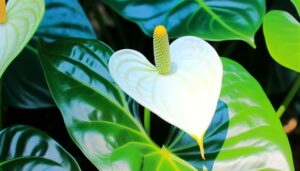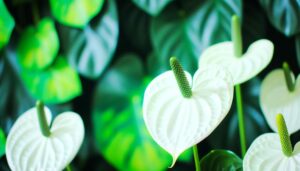7 Tips for Caring for Your Purple Anthurium Plant
To care for your purple anthurium, place it in bright, indirect sunlight, preferably near an east or north-facing window with sheer curtains. Water it when the top inch of soil is dry using filtered water, allowing excess to drain.
Use a well-draining soil mix of 40% peat moss, 40% pine bark, and 20% perlite. Maintain 60-80% humidity with daily misting and a humidity tray.
Fertilize bi-weekly with a diluted 20-20-20 water-soluble fertilizer. Prune dead leaves regularly and monitor for pests like aphids and mealybugs.
There’s more to achieving ideal plant health and growth.
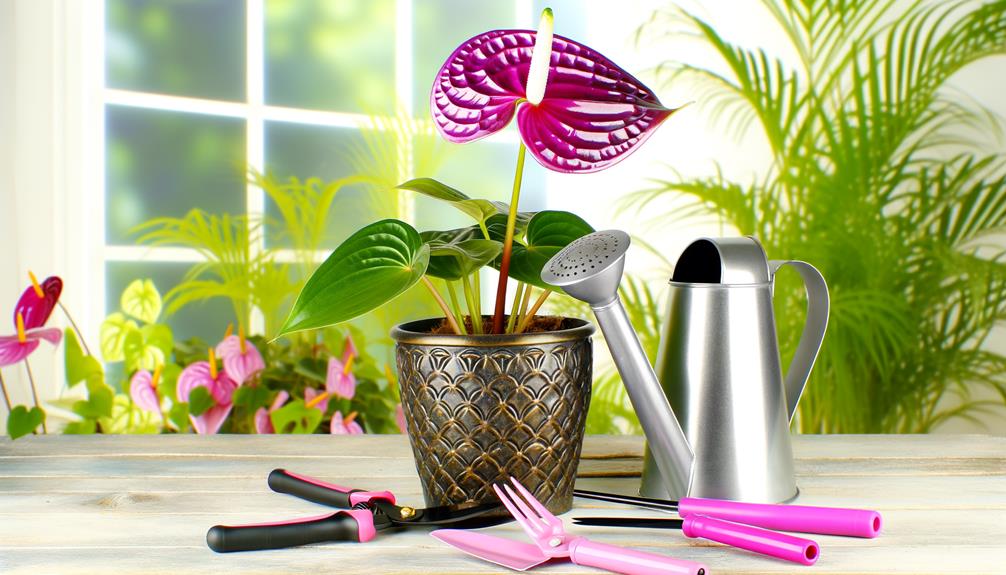
Key Takeaways
- Place your Purple Anthurium in bright, indirect sunlight near an east or north-facing window.
- Water when the top inch of soil is dry, using filtered or distilled water.
- Use a well-draining soil mix of 40% peat moss, 40% pine bark, and 20% perlite.
- Maintain 60-80% relative humidity by misting leaves daily and using a humidity tray.
- Fertilize bi-weekly with a balanced 20-20-20 N-P-K water-soluble fertilizer diluted to half-strength.
Optimal Light Conditions
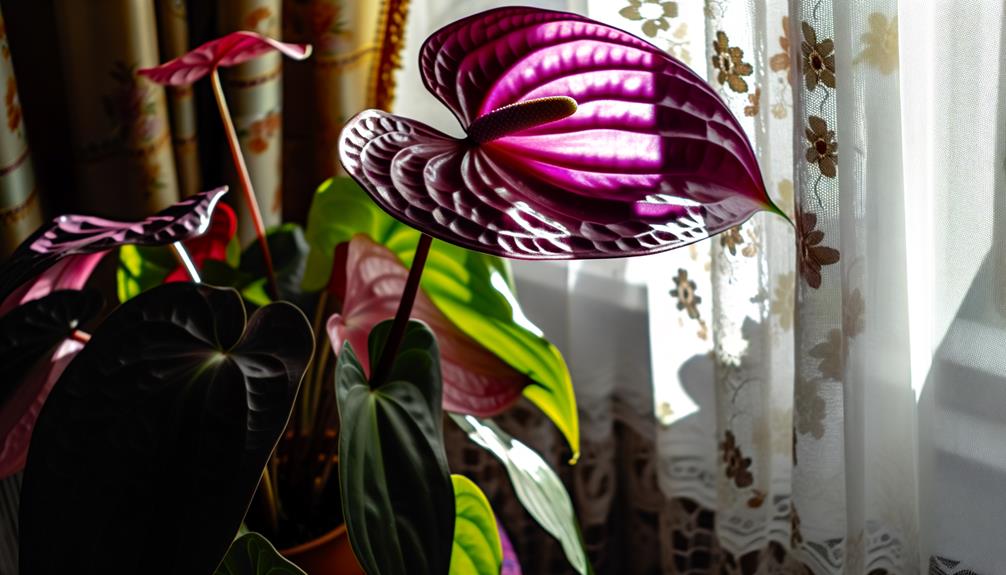
To optimize your Purple Anthurium thrives, place it in a location where it receives bright, indirect sunlight. Position it near an east or north-facing window, making sure the light is filtered through sheer curtains. Direct sunlight can scorch its leaves, causing photodamage.
If natural light is insufficient, supplement with fluorescent or LED grow lights set on a 12-hour cycle. Ensure light intensity is around 10,000 lux but not exceeding 20,000 lux to avoid photoinhibition.
Rotate the plant weekly to maintain even light distribution and prevent asymmetrical growth. Monitor the Anthurium’s leaf color; deep green indicates ideal lighting, while yellowing suggests excessive light.
Proper Watering Techniques
Maintain the health of your Purple Anthurium’s roots by watering it thoroughly when the top inch of soil feels dry to the touch.
Use a moisture meter or your finger to gauge dryness accurately. Guarantee water permeates the entire root system but avoid waterlogging, which can lead to root rot.
| Step | Description |
|---|---|
| 1 | Check soil moisture by inserting your finger 1 inch deep. |
| 2 | Water until it drains from the pot’s bottom. |
| 3 | Empty the saucer to prevent standing water. |
Remember to use filtered or distilled water to prevent mineral buildup, which can harm the plant. Adjust frequency based on seasonal changes; reduce watering in winter when growth slows. Always guarantee proper drainage to maintain root aeration.
Ideal Soil Mix

To guarantee your Purple Anthurium thrives, use a soil mix that combines well-draining components like perlite or orchid bark with rich organic matter such as peat moss.
These elements will provide adequate aeration and moisture retention, important for the plant’s root health.
Avoid compacted soils, which can lead to root rot and other issues.
Well-Draining Components
Guaranteeing your purple Anthurium thrives involves using a well-draining soil mix composed of peat moss, pine bark, and perlite for best aeration and moisture control.
Start by combining equal parts peat moss and pine bark; this mixture retains moisture while allowing excess water to drain efficiently, preventing root rot.
Then, add perlite to enhance the soil’s aeration properties. The ideal ratio is 40% peat moss, 40% pine bark, and 20% perlite. This composition promotes healthy root development and oxygen exchange.
Mix thoroughly and make sure the medium remains loose and fluffy. Avoid compacting the soil, as Anthurium roots need space to breathe.
This precise blend will keep your Anthurium’s roots healthy and thriving.
Organic Matter Inclusion
Incorporating organic material like compost or worm castings into the soil mix greatly enhances nutrient availability and microbial activity for your purple Anthurium.
Start by mixing one part compost with two parts orchid bark and one part perlite. The compost enriches the medium with essential macro and micronutrients, while the orchid bark ensures proper aeration. Perlite aids in maintaining ideal drainage, preventing root rot.
You’ll want to gently blend these components to create a loose, well-aerated mix. Maintain the pH remains slightly acidic, around 5.5 to 6.5, to support nutrient uptake. Regularly replenish the organic material to sustain soil fertility.
This careful preparation will help your Anthurium thrive, boasting vibrant, long-lasting blooms.
Humidity Levels
Maintaining ideal humidity levels is essential for the health and growth of your purple Anthurium plant. Aim for a relative humidity of 60-80%.
To achieve this, you should:
- Mist the leaves: Use distilled water to mist the leaves daily, ensuring they absorb moisture without mineral buildup.
- Use a humidity tray: Place a tray filled with water and pebbles under the plant pot. As the water evaporates, it increases humidity around the plant.
- Deploy a humidifier: Position a humidifier near your Anthurium to maintain consistent humidity levels, especially in dry indoor environments.
- Group plants together: Cluster your Anthurium with other plants to create a micro-environment with higher humidity through collective transpiration.
These methods will help your purple Anthurium thrive in ideal conditions.
Fertilizing Schedule

A balanced, water-soluble fertilizer applied bi-weekly during the growing season will provide your purple Anthurium with essential nutrients for robust growth. Select a fertilizer with an N-P-K ratio of 20-20-20 to guarantee optimal nutrient availability.
Dilute the fertilizer to half-strength to avoid root burn and nutrient overload. Apply the solution directly to the soil, guaranteeing even distribution around the root zone.
It’s crucial to monitor the plant’s response; yellowing leaves could indicate over-fertilization. During the dormant winter months, reduce the frequency to once a month, as the plant’s metabolic rate decreases.
Always water the soil thoroughly before and after fertilizing to enhance nutrient uptake and prevent salt build-up. Your attentive care will guarantee thriving, vibrant foliage.
Pruning and Maintenance
Pruning your purple Anthurium involves removing dead or damaged leaves to promote healthy growth and prevent disease. Use sterilized pruning shears to avoid introducing pathogens. Cut leaves at the base, close to the stem, ensuring a clean cut. This minimizes trauma and encourages new growth.
Inspect regularly: Check for yellowing or browning leaves weekly.
Prune selectively: Remove only what’s necessary to maintain shape and health.
Sanitize tools: Wipe blades with rubbing alcohol before and after each use.
Promote airflow: Thin out crowded areas to reduce humidity and fungal growth.
Pest Control Strategies
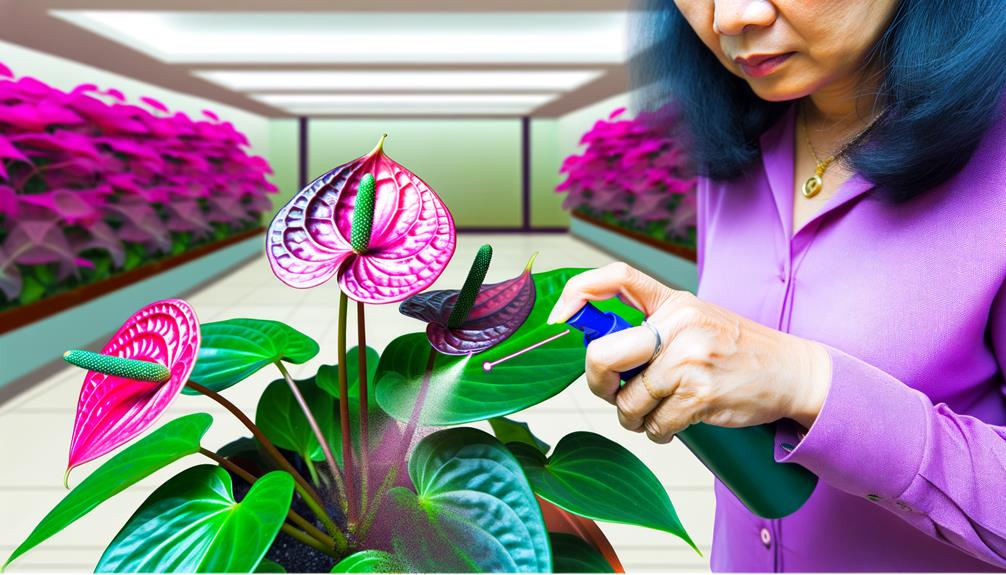
Effective pest control strategies for your purple Anthurium require vigilant monitoring for common pests such as aphids, mealybugs, and spider mites. Inspect the leaf axils and undersides regularly, where these pests often hide.
Use a magnifying glass for a detailed examination. If you spot any infestations, isolate the affected plant immediately to prevent spread.
Apply insecticidal soap or neem oil directly to the pests, ensuring thorough coverage. For severe infestations, consider using a systemic insecticide, but follow the manufacturer’s instructions meticulously.
Maintain ideal humidity and airflow to deter pests naturally. Regularly clean leaves with a damp cloth to remove dust and potential pest eggs.
Consistent monitoring and prompt action will keep your Anthurium thriving and pest-free.
Conclusion
Caring for your purple anthurium is like tending to a rare gem. Make sure it basks in filtered light, drinks water wisely, and thrives in a well-draining, peat-based mix.
Maintain humidity around 60%, fertilize bi-monthly with a balanced NPK formula, and prune dead foliage to promote growth.
Vigilantly guard against pests using neem oil. Nurture it diligently, and it’ll reward you with vibrant blooms, symbolizing the fruits of your meticulous care and botanical prowess.


